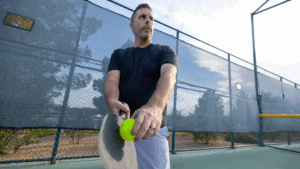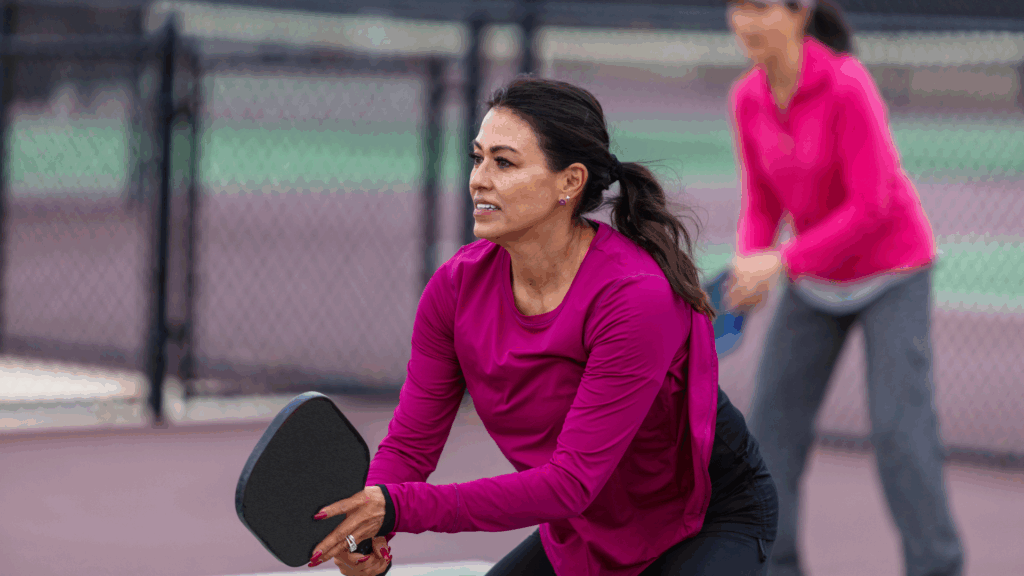
Pickleball, once a laid-back backyard pastime, has exploded into a nationwide fitness phenomenon over the past few seasons. Courts are popping up in repurposed malls, city parks, and private clubs at a pace most sports executives only dream about.
Families schedule reunions around open play, corporate wellness programs now include paddle mixers, and national broadcasters scramble to secure streaming rights for pro tours. Underneath the smiles and shouts of “Pickle!” lies a truth every committed player eventually learns: the sport’s rapid rise demands an equally rapid embrace of smarter training, recovery, and injury-prevention habits.
The numbers illuminate the shift:
19.8 million Americans played pickleball last year, a 45.8 percent leap from 2023. That surge pushes the three-year growth curve to an astonishing 311 percent, cementing pickleball as the fastest-growing sport in the United States.
Nearly 19% of U.S. adults—roughly 48 million people—have tried the game at least once in the past twelve months.
Equally striking is the changing face of the average player: once pegged at 55, the mean age now hovers around 35, proving that millennials and Gen Xers have joined boomers in droves.
This guide responds to that shift. It distills every statistic, recovery hack, and conditioning principle shared by leading coaches, physical therapists, and governing bodies into practical action steps.
Whether you are chasing gold medals on the pro circuit or vying for weekend bragging rights at the public courts, the path to more wins and fewer aches starts with informed preparation. By the final serve, you will have a playbook for playing harder, recovering faster, and staying on court for years to come.
Warmups & Recovery
Few pickleball habits pay bigger dividends than starting every session with a thoughtful warm-up and ending it with intentional recovery work.
Why Dynamic Warm-Ups Matter
Static toe touches once ruled pre-game, but research now favors movement that literally raises body temperature and rehearses game-day motions. A five-to-10-minute dynamic circuit boosts blood flow, primes muscles for explosive starts, and reduces the strains that account for nearly 29 percent of pickleball injuries. Players feel looser on the first serve and maintain sharper footwork deep into rallies.
Five-Part Pre-Game Warm-Up
Light Cardio: Two to three minutes of brisk walking, light jogging, or side-shuffles spark circulation.
Dynamic Stretching:
Arm Circles: Activate shoulders.
Trunk Rotations: Mobilize core.
Leg Swings: Loosen hips and hamstrings.
Body-Weight Activation:
Air Squats: Eight to 12 reps cue quads and glutes.
Walking Lunges: Open hips for forward lunges at the kitchen.
Balance & Footwork:
Single-Leg Stands: Strengthen ankles for lateral pushes.
Lateral Shuffles: Rehearse side-to-side bursts.
Quick Plyo:
Pogo Jumps: Fifteen seconds of springy, ankle-centric hops fire calves and Achilles for split-step reactions.
Recovery Fundamentals
Court battles tear down muscle fibers and drain fluid reserves; smart recovery rebuilds and replenishes them.
Hydrate Early, Often, Late: Water plus electrolytes prevents cramps and post-match headaches.
Refuel With Protein & Carbs: A balanced snack or meal within one hour accelerates muscle repair.
Cool-Down & Stretch: A slow lap lowers heart rate, then static holds for calves, quads, shoulders, and forearms keep connective tissue supple.
Rest & Sleep: One or two rest days weekly and seven to nine hours of nightly sleep let growth hormones mend micro-damage and fortify joints.
Popular Recovery Tools & Tech
Massage Guns: Rapid pulses untie tight quads or shoulders in minutes.
Foam Rollers: Self-myofascial release for calves, hamstrings, and upper back.
Stretch Bands: Assist deeper stretches and light resistance moves.
Compression Gear: Sleeves or boots curb swelling and muscle fatigue.
Cold Therapy: Ice packs or brief baths tame inflammation after grueling sessions.
Wearables & Apps: WHOOP straps, smart rings, and Apple Fitness+ pickleball workouts monitor strain and recommend rest or agility flows led by pro Catherine Parenteau.
Consistently pairing a dynamic warm-up with diligent recovery keeps your body game-ready, slashes injury risk, and sets the stage for more confident dinks, quicker split-steps, and longer streaks of pain-free play.
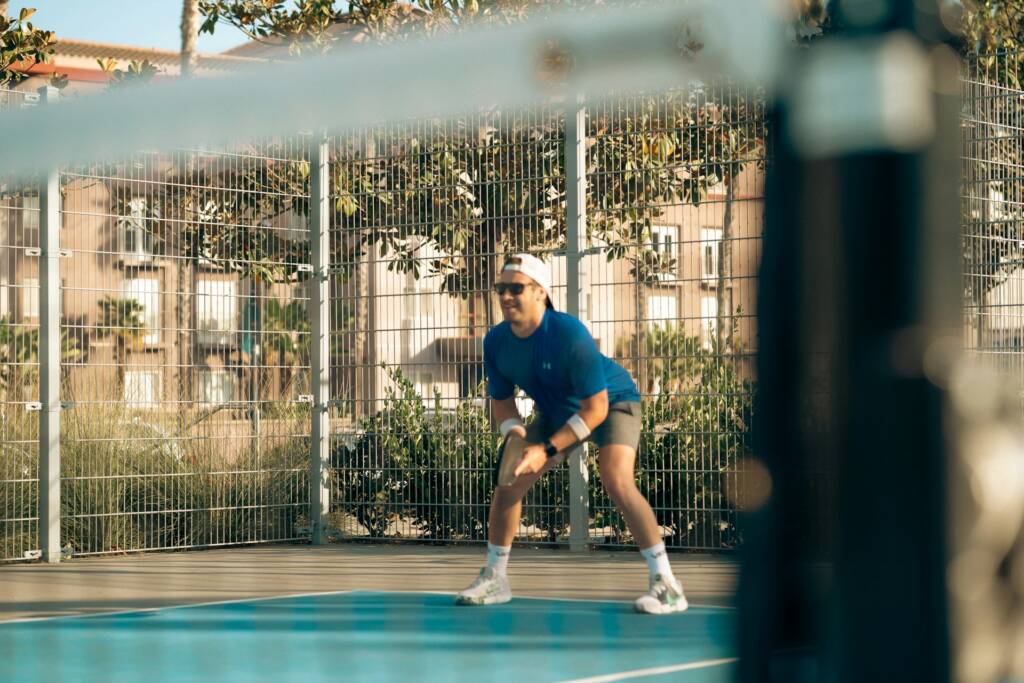
Flexibility for Pickleball
Pickleball demands lightning-quick lunges, twisting reaches, and low-stance dinks, so stiff muscles are the silent saboteurs of both power and safety.
Why Flexibility Matters On Court
Expanded Reach Equals Extra Saves: Flexible hips and hamstrings let you stretch for wide angles and low drop shots without straining.
Lower Injury Odds: Tight tissue pulls joints out of alignment, raising the chance of sprains and muscle tears that already account for almost one-third of pickleball injuries.
Efficient Movement: Limber players rotate their trunks smoothly, creating effortless paddle speed and conserving energy deep into third-game tiebreakers.
Faster Recovery: Supple muscles flush waste products quickly, shortening soreness windows after marathon open-play sessions.
Post-Play Stretch Routine
End every outing with a calm cooldown lap, then hold each static stretch for roughly thirty seconds.
Calves: Wall calf stretch keeps Achilles tendons resilient for explosive split steps.
Quads: Standing quad pull opens the front thigh and eases knee tension.
Hamstrings: Seated forward fold maintains straight-leg reach for baseline drives.
Hips & Glutes: Figure-four stretch loosens rotational chains crucial for court pivots.
Shoulders & Lats: Cross-body arm pull preserves overhead smash range.
Lower Back: Gentle lying-knee twists release post-match lumbar tightness.
Mobility Exercises That Protect Joints
While static holds improve length, dynamic mobility keeps joints moving smoothly through full ranges. Insert two or three of these drills into warm-ups, cool-downs, or rest-day circuits.
Pigeon Pose: Deep external hip opener that builds comfort in wide lunges.
Open-Gate Close-Gate: Standing hip rotations prime groin muscles for quick lateral steps.
Fire Hydrants: From all fours, lift one knee sideways to strengthen tiny hip stabilizers that safeguard knees.
Clamshells With Mini Band: Side-lying abductor drill reinforces glute medius, preventing valgus knee collapse during shuffles.
Thoracic Rotations: Half-kneeling torso twists train spinal mobility for smooth forehand rolls and two-hand backhands.
Yoga And Consistency
Integrated Practice: Downward Dog stretches calves and shoulders simultaneously, while Twisted Lunge targets hips, spine, and balance in one move.
Balance Benefits: Single-leg poses enhance proprioception, slashing fall risk that causes most pickleball fractures.
Weekly Rhythm: Three short sessions—post-match holds, midweek flow, and weekend mobility tune-up—provide steady gains without overloading busy schedules.
Community Add-Ons: Many clubs now offer “Yoga For Pickleball” evenings, creating social accountability and shared progress.
Progress Tracking: Notice improved comfort in the ready stance, deeper knee bend at the kitchen, and fewer morning aches after four consistent weeks.
Keep It Loose, Keep It Long
Flexibility is not a one-time fix but a running commitment. Attach a resistance band to your hydration pack, set a daily phone reminder, or foam-roll while streaming a match replay.
Small habits done often unlock enduring gains: wider defensive wingspan, cleaner rotational power, and joints that feel as fresh in game three as they did in warm-ups. Stay loose today so you can keep swinging tomorrow.
Strength Training
Whether you are smashing overheads or sprinting to a dink, every winning play starts with muscle power and joint stability. A dedicated strength routine transforms casual paddle swings into lightning-fast missiles and keeps nagging injuries off your schedule.
Why Strength Training Is Non-Negotiable
Bone Density Boost: Load-bearing moves reinforce skeletal strength, protecting older players from fractures.
Joint Protection: Strong muscles absorb shock, sparing knees, ankles, and shoulders from overuse wear.
Explosive Performance: Extra leg drive and core torque translate to harder serves and quicker direction changes.
All-Ages Edge: Recreational and competitive athletes alike benefit; a stronger base lets you out-rally younger opponents and out-last marathon open-play days.
Lower-Body Powerhouse
Prioritize the engine that fuels every lunge, split-step, and kitchen-line sprint.
Squats: Foundation lift for quads and glutes; perform body-weight or dumbbell versions.
Lunges: Forward, reverse, and side lunges open hips and build single-leg stability.
Calf Raises: Strengthen calves and Achilles for explosive pushes off the line.
Lateral Band Walks: Mini-band steps fire hip abductors, keeping knees aligned during shuffles.
Tip: Two sets of 12 reps on each move, two or three non-consecutive days per week, deliver noticeable pop in just four weeks.
Core Stability Zone
A well-braced core keeps you balanced in awkward reaches and powers rotational shots.
Plank Variations: Front, side, and reverse planks engage deep stabilizers.
Glute Bridges: Activate posterior chain, easing strain on the lower back during low volleys.
Russian Twists: Build oblique strength for spin serves and topspin drives.
Pro Cue: Hold each plank for thirty seconds, increase by five-second increments weekly, and pair twists with a light medicine ball for added challenge.
Upper-Body Armor
Bulletproof shoulders and strong forearms generate paddle speed while preventing elbow flare-ups.
Band Pull-Apart: Counteracts desk posture and primes scapular stabilizers.
External Rotations: Strengthen rotator cuff, reducing risk of impingement.
Wall Slides: Improve overhead mobility for confident put-aways.
Push-Ups & Dumbbell Rows: Develop balanced chest and back power for drive volleys.
Grip Builders: Wrist curls or stress-ball squeezes fortify forearms, limiting “pickleball elbow.”
Execution: Choose three moves, complete two sets of 10 reps; rotate selections each session for balanced development.
Sample Weekly Plan
Monday: Lower-body circuit plus core finish.
Wednesday: Upper-body focus with mobility warm-up.
Friday: Mixed full-body combo; finish with plank ladder.
After-Play Habit: Ten body-weight squats and ten push-ups immediately post-match keep strength work consistent even on busy days.
Duration: Each workout can fit into a 30-minute window—perfect for sneaking in before work or between league matches.
Commit to strength training two or three times weekly and you will notice firmer footwork, heavier drives, and greater endurance within a month. Your joints will thank you, your rallies will lengthen, and opponents will wonder where that extra pop came from. Grab those bands, pick up the weights, and power up your game!
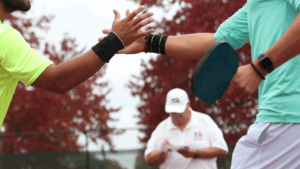
How to Stay Injury-Free While Playing Pickleball
Injury Prevention
Pickleball’s charm is its all-ages welcome mat, yet that same accessibility can tempt players to jump in unprepared. The smartest competitors treat every serve, sprint, and slam as an athletic endeavor that deserves safety safeguards as rigorous as any court drill.
Court Gear Essentials
Court Shoes: Running shoes lack side-to-side stability; choose tennis or pickleball models with sturdy lateral support and non-marking tread. Proper footwear alone slashes ankle-roll risk that fuels many sprains.
Eye Protection: Clear sports glasses block freak paddle ricochets and speedy plastic balls. Even pros have adopted lenses after close calls, so recreational players should follow suit.
Compression Options: Knee sleeves, elbow braces, or calf sleeves provide joint warmth and proprioceptive feedback, helping seasoned athletes feel stable without restricting motion.
Hydration Pack: A simple bottle plus electrolyte mix keeps muscles firing and prevents cramp-induced missteps during tournament marathons.
Smart Movement Habits
Dynamic Warm-Up: Five to ten minutes of cardio, joint rotations, and muscle activation raises core temperature and primes tendons for explosive footwork.
No Blind Backpedals: When a lob sails overhead, pivot, sprint, or let it drop—backward running causes many of the falls behind that ninety-fold fracture rise.
Communication Calls: A crisp “Mine” or “Yours” prevents mid-court collisions and awkward lunges that strain groins or shoulders.
Balanced Footwork: Train quick shuffle steps rather than crossing feet; stable bases let you decelerate safely on sharp direction changes.
Environment & Court Awareness
Surface Scan: Before first serve, check for wet patches, cracks, or pebbles. If you can twist your shoe and leave a damp trail, postpone play until dry.
Stray-Ball Sweep: Clear loose balls near sidelines each rally; stepping on a hollow sphere is an express ticket to rolled ankles.
Sun & Heat Defense: Sunscreen, hat, and frequent water breaks fend off heat exhaustion that saps focus and reaction time.
Lighting Check: Evening sessions need even illumination—shadows hide balls and foot faults that lead to missteps.
Rest & Recovery As Prevention
Scheduled Rest Days: One or two days off weekly let micro-tears repair and central nervous systems recharge, cutting chronic overuse injuries.
Sleep Priority: Seven to nine hours unlock growth hormone release and tissue rebuilding.
Post-Play Stretch: Static holds for calves, quads, hamstrings, hips, shoulders, and forearms preserve range of motion and calm muscle tone.
Nutrition & Hydration: Protein-carb snacks within an hour and consistent electrolyte intake speed recovery, keeping joints lubricated and muscles resilient.
Listen To Your Body
Early Warning Signs: Twinges, swelling, or persistent soreness mean modify intensity or seek professional guidance. Playing through pain often magnifies minor issues into months-long layoffs.
Progressive Ramp-Up: New players or returning athletes should add court time gradually—aim for two sessions the first week, three the next—rather than jumping to daily play.
Cross-Training: Strength sessions, mobility flows, and low-impact cardio spread workload across muscle groups, reducing repetitive strain on pickleball-specific joints.
Consistent safety habits transform pickleball from a seasonal fling into a lifelong relationship. Suit up with proper gear, respect dynamic warm-ups, scan your environment, honor rest, and heed body feedback. You will log more rallies, avoid costly medical detours, and keep the joy in every “Nice shot!” handshake.
Pickleball is a great way to stay fit!
Pickleball’s astonishing rise from driveway pastime to nationwide fitness movement has redefined what it means to prepare, play, and preserve your body on court.
So lace up court-specific shoes, arrive early for dynamic drills, stay late for cool-down stretches, and weave two or three strength workouts into each week. Treat hydration and sleep as non-negotiable, listen to early pain whispers, and let recovery tools—massage guns, foam rollers, compression sleeves—serve as routine maintenance, not crisis fixes.
Pickleball’s future is bright, and yours can be equally radiant when preparation meets passion. Stay disciplined, stay loose, stay strong, and the sport will reward you with endless rallies, growing friendships, and memories that age as gracefully as your well-conditioned body.
Ready For More? Visit the Pickleblog for detailed drill guides, gear reviews, and community stories that elevate every aspect of your pickleball life:
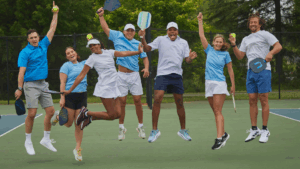
Stylish and Functional: Pickleball Apparel That Works on and off the Court
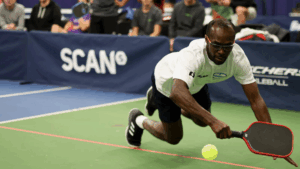
A Beginner’s Guide to Joining a Pickleball League Without Overcommitting
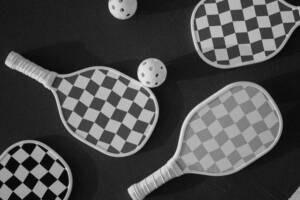
Pickleball Etiquette: What to Do (and What Not to Do) on the Court
